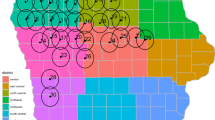Abstract
Remote sensing data are often measured or reported over wide spatial footprints with heterogeneous ground cover. Different types of vegetation, however, have unique signatures that evolve throughout the growing season. Without additional information, signals corresponding to individual vegetation types are unidentifiable from satellite measurements. In this paper, we propose a parametric mixture model to describe satellite data monitoring crop development in the US Corn Belt. The ground cover of each satellite footprint is primarily a mixture of corn and soybean. Using auxiliary data from multiple sources, we model the aggregate satellite signal, and identify the signatures of individual crop types, using nonlinear parametric functions. Estimation is performed using a Bayesian approach, and information from auxiliary data is incorporated into the prior distributions to identify distinct crop types. We demonstrate our parametric unmixing approach using data from the European Space Agency’s Soil Moisture and Ocean Salinity satellite. Lastly, we compare our model estimates for the timing of key crop phenological stages to USDA ground-based estimates.
Supplementary materials accompanying this paper appear online.









Similar content being viewed by others
References
Atkinson, P. M., Jeganathan, C., Dash, J., and Atzberger, C. (2012), “Inter-comparison of four models for smoothing satellite sensor time-series data to estimate vegetation phenology,” Remote Sensing of Environment, 123, 400–417.
Beck, P. S., Atzberger, C., Høgda, K. A., Johansen, B., and Skidmore, A. K. (2006), “Improved monitoring of vegetation dynamics at very high latitudes: A new method using MODIS NDVI,” Remote Sensing of Environment, 100, 321–334.
Betancourt, M. and Girolami, M. (2015), “Hamiltonian Monte Carlo for hierarchical models,” Current trends in Bayesian methodology with applications, 79–101.
Department of Agronomy. Iowa State University (Accessed September 30, 2018), “Iowa Environmental Mesonet.” https://mesonet.agron.iastate.edu/.
Dobigeon, N., Moussaoui, S., Coulon, M., Tourneret, J.-Y., and Hero, A. O. (2009), “Joint Bayesian endmember extraction and linear unmixing for hyperspectral imagery,” IEEE Transactions on Signal Processing, 57, 4355–4368.
Dobigeon, N., Tourneret, J.-Y., Richard, C., Bermudez, J. C. M., McLaughlin, S., and Hero, A. O. (2014), “Nonlinear unmixing of hyperspectral images: Models and algorithms,” IEEE Signal Processing Magazine, 31, 82–94.
Geweke, J. (1992), “Evaluating the Accuracy of Sampling-Based Approaches to the Calculation of Posterior Moments,” in In Bayesian Statistics, University Press, pp. 169–193.
Hornbuckle, B. K., Patton, J. C., VanLoocke, A., Suyker, A. E., Roby, M. C., Walker, V. A., Iyer, E. R., Herzmann, D. E., and Endacott, E. A. (2016), “SMOS optical thickness changes in response to the growth and development of crops, crop management, and weather,” Remote Sensing of Environment, 180, 320–333.
Ihaka, R. and Gentleman, R. (1996), “R: a language for data analysis and graphics,” Journal of Computational and Graphical Statistics, 5, 299–314.
Jackson, T. and Schmugge, T. (1991), “Vegetation effects on the microwave emission of soils,” Remote Sensing of Environment, 36, 203–212.
Kerr, Y. H., Waldteufel, P., Richaume, P., Wigneron, J. P., Ferrazzoli, P., Mahmoodi, A., Al Bitar, A., Cabot, F., Gruhier, C., Juglea, S. E., et al. (2012), “The SMOS soil moisture retrieval algorithm,” IEEE Transactions on Geoscience and Remote Sensing, 50, 1384–1403.
Keshava, N. (2003), “A survey of spectral unmixing algorithms,” Lincoln laboratory journal, 14, 55–78.
Lawrence, H., Wigneron, J.-P., Richaume, P., Novello, N., Grant, J., Mialon, A., Al Bitar, A., Merlin, O., Guyon, D., Leroux, D., et al. (2014), “Comparison between SMOS Vegetation Optical Depth products and MODIS vegetation indices over crop zones of the USA,” Remote Sensing of Environment, 140, 396–406.
McMaster, G. S. and Wilhelm, W. (1997), “Growing degree-days: one equation, two interpretations,” Agricultural and forest meteorology, 87, 291–300.
Patton, J. and Hornbuckle, B. (2013), “Initial validation of SMOS vegetation optical thickness in Iowa,” IEEE Geoscience and Remote Sensing Letters, 10, 647–651.
Plummer, M., Best, N., Cowles, K., and Vines, K. (2006), “CODA: Convergence Diagnosis and Output Analysis for MCMC,” R News, 6, 7–11.
Stan Development Team (2016), “RStan: the R interface to Stan,” http://mc-stan.org, R package version 2.14.1.
USDA-NASS (Accessed September 30, 2018), “NASS Weekly Crop Reports.” https://www.nass.usda.gov/Publications/Reports_By_Date/.
— (Accessed September 30, 2018), “USDA National Agricultural Statistics Service Cropland Data Layer. Published crop-specific data layer.” https://nassgeodata.gmu.edu/CropScape/.
Wei, Q., Bioucas-Dias, J., Dobigeon, N., and Tourneret, J.-Y. (2015), “Hyperspectral and multispectral image fusion based on a sparse representation,” IEEE Transactions on Geoscience and Remote Sensing, 53, 3658–3668.
Xue, J., Leung, Y., and Fung, T. (2017), “A Bayesian data fusion approach to spatio-temporal fusion of remotely sensed images,” Remote Sensing, 9, 1310.
Zeng, L., Wardlow, B. D., Wang, R., Shan, J., Tadesse, T., Hayes, M. J., and Li, D. (2016), “A hybrid approach for detecting corn and soybean phenology with time-series MODIS data,” Remote Sensing of Environment, 181, 237–250.
Zhang, L., Fu, D., Sun, X., Chen, H., and She, X. (2016), “A spatial-temporal-spectral blending model using satellite images,” in IOP Conference Series: Earth and Environmental Science, IOP Publishing, vol. 34, p. 012042.
Author information
Authors and Affiliations
Corresponding author
Additional information
Publisher's Note
Springer Nature remains neutral with regard to jurisdictional claims in published maps and institutional affiliations.
Electronic supplementary material
Below is the link to the electronic supplementary material.
Rights and permissions
About this article
Cite this article
Lewis-Beck, C., Zhu, Z., Mondal, A. et al. A Parametric Approach to Unmixing Remote Sensing Crop Growth Signatures. JABES 24, 502–516 (2019). https://doi.org/10.1007/s13253-019-00368-0
Received:
Revised:
Accepted:
Published:
Issue Date:
DOI: https://doi.org/10.1007/s13253-019-00368-0




